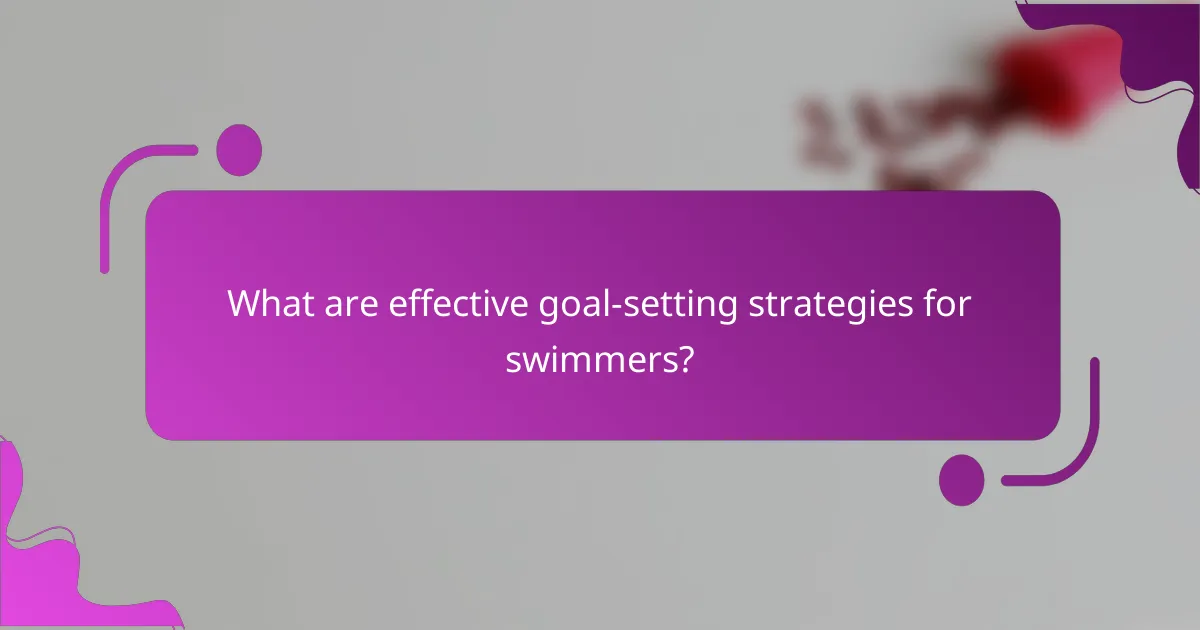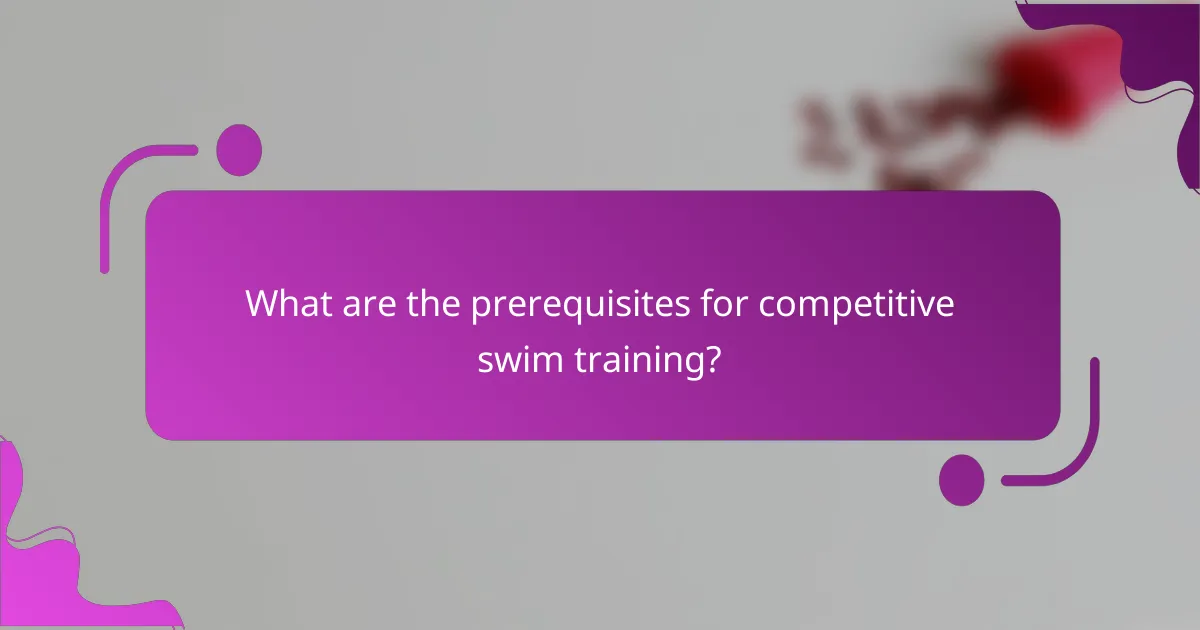Competitive swim training is a multifaceted approach that emphasizes performance analysis, personalized goal setting, and mental preparation. By honing technique and implementing tailored training plans, swimmers can enhance their abilities and minimize injury risks. Additionally, effective goal-setting strategies and mental training techniques play crucial roles in maintaining motivation and improving race outcomes.

How can competitive swim training improve performance in Australia?
Competitive swim training in Australia enhances performance by focusing on technique, personalized plans, and injury prevention. These elements work together to help swimmers achieve their goals and excel in competitions.
Enhanced technique through video analysis
Video analysis allows swimmers to visually assess their stroke mechanics and overall technique. By reviewing footage, athletes can identify areas for improvement, such as body position, stroke efficiency, and breathing patterns.
Coaches can use this technology to provide immediate feedback, enabling swimmers to make real-time adjustments. Regular video sessions can lead to significant performance gains, often translating to improved race times.
Personalized training plans
Personalized training plans are tailored to an athlete’s specific strengths, weaknesses, and goals. These plans consider factors like current fitness levels, competition schedules, and individual learning styles.
In Australia, many coaches utilize periodization strategies to optimize training cycles, ensuring that swimmers peak at the right time for major competitions. This approach helps maintain motivation and reduces the risk of burnout.
Injury prevention strategies
Injury prevention is crucial for competitive swimmers to maintain consistent training and performance. Strategies include strength training, flexibility exercises, and proper warm-up routines to prepare the body for rigorous workouts.
Swimmers should also pay attention to their technique, as poor form can lead to overuse injuries. Regular assessments and adjustments to training loads can help mitigate risks and keep athletes in peak condition.

What are effective goal-setting strategies for swimmers?
Effective goal-setting strategies for swimmers involve creating clear, measurable objectives that guide training and performance. By establishing specific targets, swimmers can track their progress and stay motivated throughout their training cycles.
SMART goals framework
The SMART goals framework is a popular method for setting effective objectives. SMART stands for Specific, Measurable, Achievable, Relevant, and Time-bound. For example, instead of saying “I want to swim faster,” a SMART goal would be “I want to improve my 100-meter freestyle time by 2 seconds within the next three months.” This clarity helps swimmers focus their efforts and measure success.
When applying the SMART framework, ensure that each goal aligns with your overall training plan and personal aspirations. Regularly review and adjust these goals based on performance data and changing circumstances to maintain relevance and motivation.
Short-term vs long-term goals
Short-term goals are typically set to be achieved within weeks or months and serve as stepping stones toward larger objectives. For instance, a swimmer might aim to improve their lap time in practice or master a new technique. These goals provide immediate focus and can boost confidence as they are accomplished.
Long-term goals, on the other hand, span several months to years and often align with major competitions or personal milestones. Examples include qualifying for a national championship or achieving a personal best in a specific event. Balancing short-term and long-term goals allows swimmers to maintain motivation while working toward significant achievements.

How does mental preparation impact swim performance?
Mental preparation significantly enhances swim performance by improving focus, reducing anxiety, and boosting confidence. Athletes who engage in mental training techniques often experience better race outcomes and improved overall performance.
Visualization techniques
Visualization techniques involve mentally rehearsing swim races and techniques to enhance performance. Swimmers can picture themselves executing strokes perfectly, feeling the water, and achieving their desired times. This practice can help solidify muscle memory and reduce pre-race nerves.
To effectively use visualization, swimmers should find a quiet space, close their eyes, and vividly imagine their race from start to finish. Regular practice, ideally several times a week, can lead to significant improvements in both confidence and execution during actual competitions.
Mindfulness practices
Mindfulness practices focus on being present and aware, which can help swimmers manage stress and maintain concentration. Techniques such as deep breathing and meditation can ground athletes, allowing them to stay calm and focused during competitions.
Incorporating mindfulness into training can be as simple as dedicating a few minutes before each practice to breathing exercises or reflecting on the day’s goals. Regular engagement in these practices can lead to better emotional regulation and improved performance under pressure.

What tools are available for performance analysis?
Performance analysis in competitive swimming involves various tools that help athletes and coaches assess technique, speed, and overall effectiveness. These tools can enhance training by providing data-driven insights and feedback.
Swim analysis software
Swim analysis software is designed to evaluate swimmers’ techniques and performance metrics. Programs like SwimPro and Dartfish allow users to record video, analyze stroke mechanics, and track progress over time. These platforms often include features such as side-by-side comparisons and detailed metrics on stroke rate and distance per stroke.
When selecting swim analysis software, consider factors like ease of use, compatibility with devices, and the specific metrics you want to track. Many software options offer trial versions, allowing you to test their capabilities before committing financially.
Wearable technology for tracking
Wearable technology, such as swim watches and smart goggles, provides real-time tracking of performance metrics like lap times, stroke counts, and heart rate. Devices from brands like Garmin and FINIS can sync with apps to provide detailed insights and historical data analysis.
When choosing wearable technology, look for features that suit your training needs, such as waterproof capabilities and battery life. Ensure the device is comfortable and does not hinder your performance in the water. Regularly reviewing the data collected can help identify trends and areas for improvement in your training regimen.

What are the prerequisites for competitive swim training?
Prerequisites for competitive swim training include a solid foundation in swimming skills, physical fitness assessments, and mental readiness. These elements ensure that athletes are prepared to engage in rigorous training and competition effectively.
Basic swimming skills
Basic swimming skills are essential for any competitive swimmer. This includes proficiency in various strokes such as freestyle, backstroke, breaststroke, and butterfly, along with effective starts and turns. Swimmers should be comfortable in the water and able to swim distances typically ranging from 50 to 200 meters without fatigue.
To assess basic swimming skills, coaches often conduct drills that focus on technique, speed, and endurance. Regular practice and feedback can help swimmers refine their abilities and prepare for more advanced training.
Physical fitness assessments
Physical fitness assessments evaluate a swimmer’s overall strength, endurance, and flexibility. Common tests include timed swims, dryland exercises, and flexibility measurements. These assessments help identify areas for improvement and set benchmarks for progress.
Swimmers should aim for a balanced fitness routine that includes cardiovascular training, strength exercises, and flexibility work. For example, incorporating activities like running, weightlifting, and yoga can enhance performance in the pool. Regular assessments, ideally every few months, can help track improvements and adjust training plans accordingly.

How can swimmers in Australia stay motivated?
Swimmers in Australia can stay motivated by engaging with their local communities and setting clear, achievable goals. By participating in swim clubs and competitions, they can foster a sense of belonging and purpose in their training.
Joining local swim clubs
Joining a local swim club provides swimmers with a supportive environment that encourages regular practice and camaraderie. Clubs often organize training sessions, social events, and group competitions, which can enhance motivation and accountability.
In Australia, many clubs cater to various skill levels, from beginners to elite athletes. Swimmers should look for clubs that align with their goals, whether it’s improving technique or preparing for competitions.
Setting up competitions
Setting up competitions, whether informal or formal, can significantly boost motivation for swimmers. Regularly scheduled meets give swimmers specific targets to aim for, helping them track progress and stay engaged with their training.
Swimmers can participate in local events, such as club championships or regional meets, which are often held throughout the year. These competitions not only provide a platform to showcase skills but also foster a competitive spirit that can drive improvement.

What emerging trends are shaping competitive swim training?
Emerging trends in competitive swim training focus on data-driven performance analysis, personalized goal setting, and mental preparation strategies. These trends aim to enhance swimmers’ efficiency, resilience, and overall performance in the pool.
Performance analysis
Performance analysis in competitive swimming involves using technology to track and assess swimmers’ metrics, such as stroke efficiency, speed, and endurance. Coaches often utilize video analysis and wearable devices to gather data that informs training adjustments and technique improvements.
Key considerations include identifying strengths and weaknesses through metrics like split times and stroke counts. Coaches can then tailor training sessions to address specific areas, ensuring that swimmers maximize their potential during competitions.
Goal setting
Effective goal setting in competitive swim training is crucial for maintaining motivation and focus. Swimmers should establish both short-term and long-term goals, ensuring they are specific, measurable, achievable, relevant, and time-bound (SMART).
For instance, a swimmer might aim to reduce their 100-meter freestyle time by a few seconds within a season. Regularly reviewing and adjusting these goals based on performance feedback can help swimmers stay on track and adapt to their evolving capabilities.
Mental preparation
Mental preparation is increasingly recognized as a vital component of competitive swim training. Techniques such as visualization, mindfulness, and positive self-talk can enhance a swimmer’s focus and confidence during competitions.
Swimmers should incorporate mental training into their routines, dedicating time to visualize successful races and practice relaxation techniques. This preparation can help reduce anxiety and improve performance under pressure, ultimately contributing to better race outcomes.
